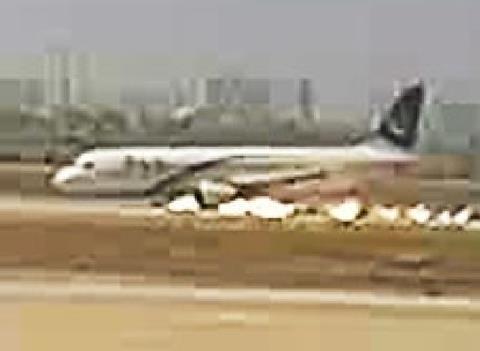Investigators have not clarified why the crew of a Pakistan International Airlines Airbus A320 retracted the landing-gear during its descent and approach to Karachi, but the blunder featured in a catalogue of poor airmanship which preceded the aircraft’s fatal crash.
The aircraft ultimately made a gear-up touchdown on runway 25L, damaging its engines, before the crew attempted a go-around, during which the jet lost height and came down in a residential suburb.
Its initial approach to 25L had been mismanaged. The aircraft was excessively high, passing a waypoint designated SABEN at 7,830ft when the approach from this point should have commenced at just 3,000ft.
The speed brakes had already been extended. The crew extended the landing-gear at 7,239ft, some 10nm from the runway, and pitched the aircraft 7.4° nose-down.
Although Karachi approach control informed the crew that they could perform an orbit, this was refused, with the crew responding that they were “comfortable we can make it”.
The jet continued to dive, with a rate of descent exceeding 4,000ft/min, and when approach control instructed the crew to make a 180° left turn, the crew simply reiterated that they were “comfortable”, established on the ILS for 25L, and descending through 3,500ft for 3,000ft – even though the aircraft was actually at 3,900ft.
A second instruction to make the 180° turn was similarly disregarded.
At 5.5nm from the runway, the aircraft was still at 2,730ft and pitched 13.7° nose-down – an attitude which caused the autopilot to disconnect – with a descent rate of 6,800ft/min, which increased to 7,400ft/min.
Overspeed warnings sounded owing to the aircraft’s airspeed reaching 261kt, some 31kt higher than the limit for its flap configuration. The first officer, who was flying, pulled back on his sidestick to arrest the descent.
The inquiry states that, about the same time, the ground-proximity warning system issued a ‘sink rate’ and two ‘pull up’ alerts. No call-out was made by the crew, and no go-around was initiated.
But almost immediately after the ‘pull up’ alerts, at about 1,600ft and 5nm, the landing-gear lever was selected ‘up’, and the undercarriage retracted. The speed brakes were retracted a few seconds later.
Both retractions were selected by the first officer, the inquiry believes, but it says neither was verbalised.
The inquiry has not indicated a reason for the decision to raise the landing-gear.
But it states that, almost simultaneously, the aircraft was granted landing clearance and, a few seconds later, it finally acquired the 3° glideslope at 1,400ft.

As the A320 descended, overspeed warnings continued to sound because the crew selected flap configurations before the aircraft had decelerated below speed limits for the settings.
The jet deviated above the glideslope, and the first officer asked the captain whether they should perform an orbit. The captain rejected the suggestion, and took over the flight controls.
Analysis of the aircraft’s final approach reveals multiple alerts, including ‘pull up’ warnings, were triggered while cockpit indications showed the continuing overspeed condition and the fact that the landing-gear was still retracted.
The crew did not execute a go-around but proceeded with the unstable approach, selecting full reverse thrust on both engines at 7ft, just before touchdown – although the reversers did not deploy because sensors detected the aircraft was still airborne.
Investigators state that the aircraft’s engine nacelles contacted the ground nearly 4,500ft along runway 25L.
Maximum braking was recorded for 14s. Both pilots applied sidestick inputs, in opposite directions – the first officer pulling nose-up, while the captain pushed nose-down.
Both thrust levers had been set to maximum-reverse, but were advanced to full power after the first officer urged the captain to take off. The aircraft became airborne but the go-around was unsuccessful and the badly-damaged jet crashed about 1,340m short of the 25L threshold during its second approach attempt.
Two of the 99 occupants, both of them passengers, survived the 22 May 2020 crash.























